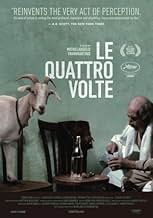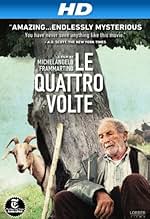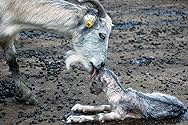VALUTAZIONE IMDb
7,2/10
4415
LA TUA VALUTAZIONE
Un vecchio pastore vive i suoi ultimi giorni in un tranquillo borgo medievale arroccato sulle colline della Calabria, all'estremità meridionale d'Italia. Sopravvive con le capre abbandonate ... Leggi tuttoUn vecchio pastore vive i suoi ultimi giorni in un tranquillo borgo medievale arroccato sulle colline della Calabria, all'estremità meridionale d'Italia. Sopravvive con le capre abbandonate molto tempo fa per gli abitanti del villaggio.Un vecchio pastore vive i suoi ultimi giorni in un tranquillo borgo medievale arroccato sulle colline della Calabria, all'estremità meridionale d'Italia. Sopravvive con le capre abbandonate molto tempo fa per gli abitanti del villaggio.
- Regia
- Sceneggiatura
- Star
- Premi
- 14 vittorie e 14 candidature totali
Recensioni in evidenza
My main study is in the nature of insight and immersion, the mechanisms that control it, linked to meditation, so a lot of these slow-paced/ meditational films are recommended to me by friends and users on here. Very few work, and for every Antonioni there are three times as many Tsai Ming-Liangs. This one does.
The difference between one that works and others, which is the difference between meditation and sleep, is how well the filmmaker structures. It's not enough to convey an empty room, there has to be somehow someone there who is just a few words short of self and the room still being empty.
The structure here is that we have three worlds, three burials (four, if we listen to the filmmaker). Dissolution of one means birth in the next, and the whole is being spun because we breathe in the world of the film. In between we get the transient flow of things simply being themselves. We get rituals of living that pass the time, from the absurd Roman parade to sweeping a church floor to herding and playtime among baby goats, rituals about the passing of time like the one with the tallest tree cut down and erected as the center of a ceremony then symbolically cut down again, and our film as a ritual that reflects both kinds of passing.
Its function is like the mandala of Tibetans, a space where you still the mind until you begin to notice more than painted symmetry. From passing time to observation about the passing.
I would have preferred a little less quirkiness from Tati in the individual parts and a little more purity but that is a minor complaint. If you like this, look out for a guy called Ben Rivers.
The end is not an end in the classical sense and only recycled being, another mandala here. But you have to see it. What is the smoke of burned trees blowing out to the forest but transformation, the forest returning to itself? There's a beautiful Zen saying about this.
The difference between one that works and others, which is the difference between meditation and sleep, is how well the filmmaker structures. It's not enough to convey an empty room, there has to be somehow someone there who is just a few words short of self and the room still being empty.
The structure here is that we have three worlds, three burials (four, if we listen to the filmmaker). Dissolution of one means birth in the next, and the whole is being spun because we breathe in the world of the film. In between we get the transient flow of things simply being themselves. We get rituals of living that pass the time, from the absurd Roman parade to sweeping a church floor to herding and playtime among baby goats, rituals about the passing of time like the one with the tallest tree cut down and erected as the center of a ceremony then symbolically cut down again, and our film as a ritual that reflects both kinds of passing.
Its function is like the mandala of Tibetans, a space where you still the mind until you begin to notice more than painted symmetry. From passing time to observation about the passing.
I would have preferred a little less quirkiness from Tati in the individual parts and a little more purity but that is a minor complaint. If you like this, look out for a guy called Ben Rivers.
The end is not an end in the classical sense and only recycled being, another mandala here. But you have to see it. What is the smoke of burned trees blowing out to the forest but transformation, the forest returning to itself? There's a beautiful Zen saying about this.
Would that life in life in an isolated village in Calabria, or any other place be as beautiful and silent.
There was not one word of dialog in the film. The only utterances was the dog barking and the sheep bleating.
An old man dies and presumably is reborn as a goat. The goat dies and it subsumed into a tree. The tree becomes charcoal, a mineral and dust.
Dust thou art and to dust thy shall return.
Matter is neither created nor destroyed.
Pick your interpretation.
It was a film to contemplate. It was full of Christian imagery, but it also stimulates mediation.
Not for everybody, but it was a beautiful film.
There was not one word of dialog in the film. The only utterances was the dog barking and the sheep bleating.
An old man dies and presumably is reborn as a goat. The goat dies and it subsumed into a tree. The tree becomes charcoal, a mineral and dust.
Dust thou art and to dust thy shall return.
Matter is neither created nor destroyed.
Pick your interpretation.
It was a film to contemplate. It was full of Christian imagery, but it also stimulates mediation.
Not for everybody, but it was a beautiful film.
I saw this film in Norway where it recently came out in the cinemas.
The title refers to the four seasons and the story follows a cycle of birth, death and rebirth. There is a symmetry in the film, and each part focuses on the fate of one individual (a farmer, a goat and a tree, for instance).
The film makes effective use of the beautiful landscape of Calabria, and the old, ramshackle village. The setting is perhaps in itself the main character of the film. Humans are often viewed from above, and we are in a sense getting the "God" treatment.
There is barely any plot or a story to speak of, yet we go through stages of life that are eternal and inevitable - and we are reminded again and again that all things must pass.
There are life-like documentary aspects to this feature. The film is shot in available light with amateur actors and animals that will endear you. The result is breathtaking and inspiring. The sound scape is also rich: it helps create an emotional journey through every chapter of the film.
I can highly recommend this to anyone interested in unusual films with no dialogue or discernible plot, but anyone also will no doubt be captivated by it's gorgeous setting, it's humble characters or the feeling of watching life pass, unfiltered.
The title refers to the four seasons and the story follows a cycle of birth, death and rebirth. There is a symmetry in the film, and each part focuses on the fate of one individual (a farmer, a goat and a tree, for instance).
The film makes effective use of the beautiful landscape of Calabria, and the old, ramshackle village. The setting is perhaps in itself the main character of the film. Humans are often viewed from above, and we are in a sense getting the "God" treatment.
There is barely any plot or a story to speak of, yet we go through stages of life that are eternal and inevitable - and we are reminded again and again that all things must pass.
There are life-like documentary aspects to this feature. The film is shot in available light with amateur actors and animals that will endear you. The result is breathtaking and inspiring. The sound scape is also rich: it helps create an emotional journey through every chapter of the film.
I can highly recommend this to anyone interested in unusual films with no dialogue or discernible plot, but anyone also will no doubt be captivated by it's gorgeous setting, it's humble characters or the feeling of watching life pass, unfiltered.
Le Quattro Volte is the essence of fine film making, of film making as art that does not need to rely on technological camouflage to tell an engrossing human story. Who needs violence, car chases, explosions, and overwhelming special effects when there are films like this to be seen? If you have ever spent just a single day allowing yourself to be totally absorbed into a small, isolated town (this one just happens to be in the hills of southern Italy), this film will evoke visceral feelings from deep within you of recollection, pathos, and respect for tradition and simple human dignity. With practically no dialog, it is a visual tone poem that speaks volumes about the nature, pace, toils, loneliness, and devotion to ritual of small, traditional communities everywhere.
As charming and visually captivating as this film may be, it lacks content which at times seems to be filled with shots that are too long or that do not provide relevant elements to the film (besides offering the already mentioned captivating visuals) and that after a while become exhausting. The problem with this film is that it's too long for it's content but if it had been done as a short it would have probably lacked atmosphere.
This extensive use of long lasting shots and static moments at some point stop creating reflection moments and instead create reasons for the audience to grow bored which, to some extent, takes the effectiveness off the ending. Slow paced movies have to work in a particular way so that the audience may remain focused on the plot, to do this, things have to happen within the story presented; that rarely happens here.
So as other reviews mentioned, if the viewer has the desire to have a closer look at the rural Italian life, yeah, they'll find a sort of... well, slow view of what that is. If you're looking for an art-house kind of thing, this doesn't really work either. The real problem is that it doesn't either show enough rural life in terms of a documentary, nor is it deep enough to be a successful fiction film. Cute, but really wasn't able to engage the story.
This extensive use of long lasting shots and static moments at some point stop creating reflection moments and instead create reasons for the audience to grow bored which, to some extent, takes the effectiveness off the ending. Slow paced movies have to work in a particular way so that the audience may remain focused on the plot, to do this, things have to happen within the story presented; that rarely happens here.
So as other reviews mentioned, if the viewer has the desire to have a closer look at the rural Italian life, yeah, they'll find a sort of... well, slow view of what that is. If you're looking for an art-house kind of thing, this doesn't really work either. The real problem is that it doesn't either show enough rural life in terms of a documentary, nor is it deep enough to be a successful fiction film. Cute, but really wasn't able to engage the story.
Lo sapevi?
- QuizThe film is comprised of long takes. One of them lasts an astounding 8 minutes.
- Curiosità sui creditiThe end credits also include a silver fir, the goats of Caulonia and the coal of Calabria among the cast members.
- ConnessioniFeatured in Ebert Presents: At the Movies: Episodio #1.15 (2011)
I più visti
Accedi per valutare e creare un elenco di titoli salvati per ottenere consigli personalizzati
- How long is Le Quattro Volte?Powered by Alexa
Dettagli
- Data di uscita
- Paesi di origine
- Sito ufficiale
- Lingua
- Celebre anche come
- Le Quattro Volte
- Luoghi delle riprese
- Aziende produttrici
- Vedi altri crediti dell’azienda su IMDbPro
Botteghino
- Lordo Stati Uniti e Canada
- 152.530 USD
- Fine settimana di apertura Stati Uniti e Canada
- 16.192 USD
- 3 apr 2011
- Lordo in tutto il mondo
- 717.918 USD
- Tempo di esecuzione
- 1h 28min(88 min)
- Colore
- Mix di suoni
- Proporzioni
- 1.85 : 1
Contribuisci a questa pagina
Suggerisci una modifica o aggiungi i contenuti mancanti





















